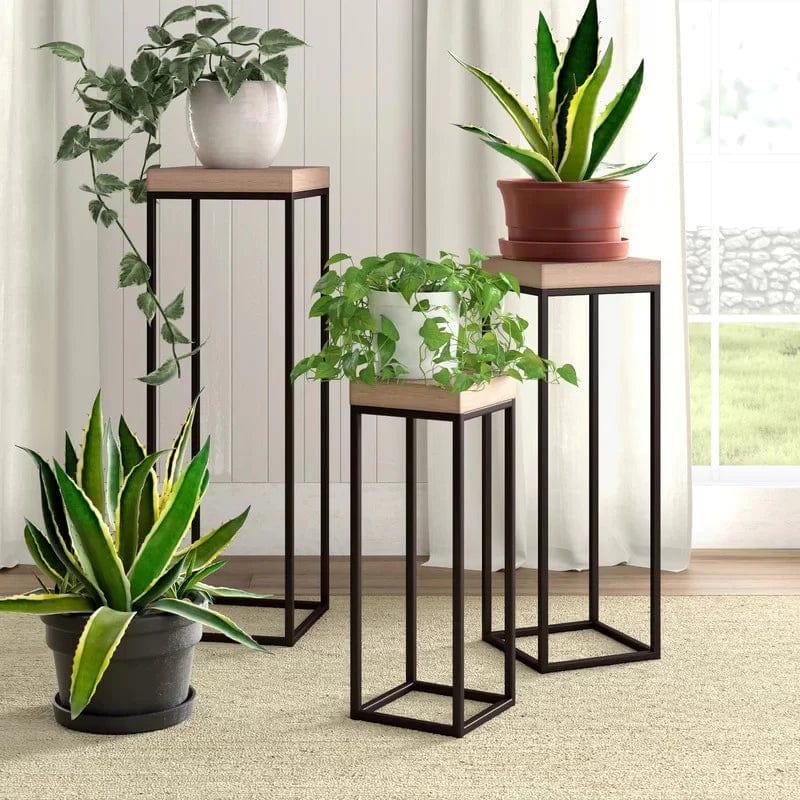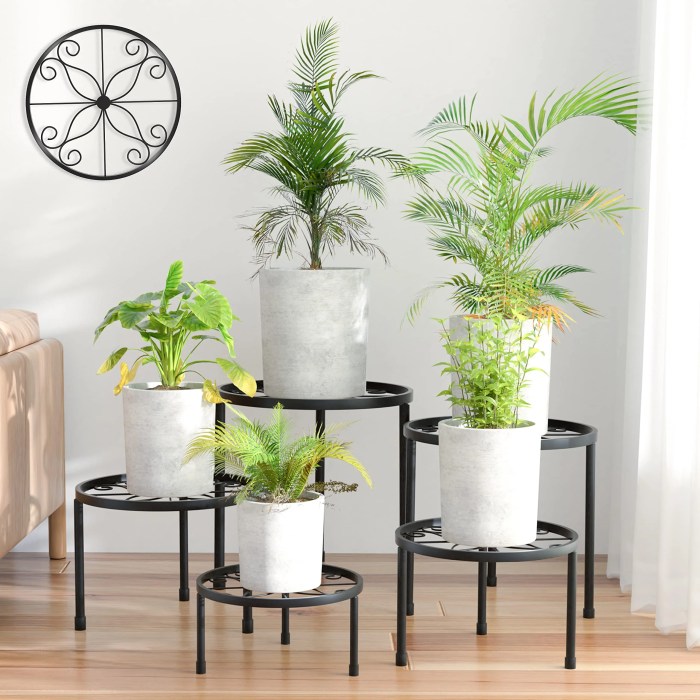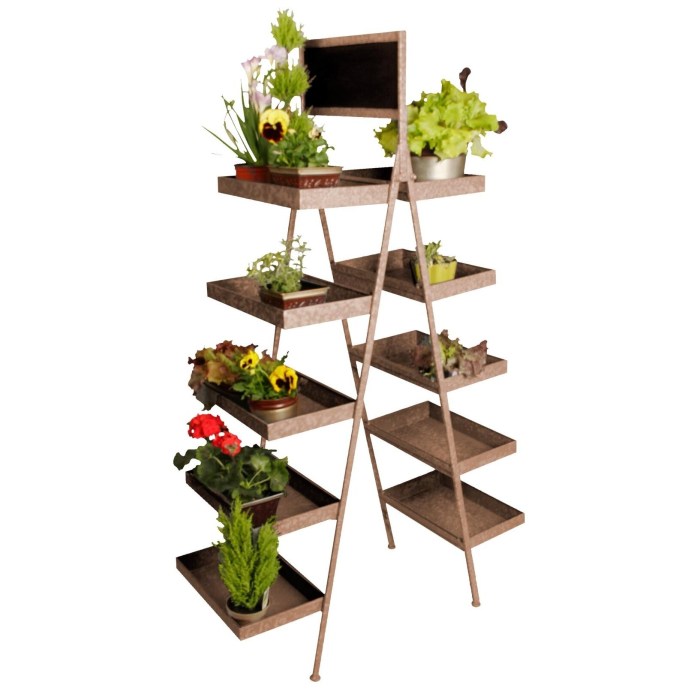Nesting plant stand furniture with tiers offers a stylish and space-saving solution for displaying your beloved plants. These versatile stands, often designed with multiple levels, allow you to create a lush indoor garden, even in smaller spaces. Their nesting design provides convenient storage when not in use, making them ideal for apartments or homes where flexibility is key.
The tiered structure maximizes vertical space, allowing you to showcase a variety of plants with varying heights and sizes, creating a visually appealing and organized display.
The choice of materials varies widely, from sleek metal to rustic wood, offering a range of aesthetic options to complement any interior design. Consider factors such as the weight capacity of each tier, the overall stability of the stand, and the ease of assembly and maintenance when making your selection. Proper placement, considering sunlight and watering needs, is also crucial for the health and longevity of your plants.
Nesting plant stands, also known as tiered plant stands or stacking plant stands, offer a stylish and space-saving solution for displaying your beloved indoor plants. These versatile pieces of furniture come in various materials, styles, and sizes, allowing you to create a personalized botanical haven in any room. This comprehensive guide will delve into the world of nesting plant stands, exploring their benefits, different types, design considerations, and care tips.
We’ll also address frequently asked questions to help you make an informed decision when choosing the perfect nesting plant stand for your home.
Benefits of Using Nesting Plant Stands: Nesting Plant Stand Furniture With Tiers
Nesting plant stands provide numerous advantages over traditional single-tiered plant stands or placing plants directly on the floor. Their key benefits include:

- Space Saving: Their nesting design allows for compact storage when not in use, making them ideal for smaller spaces or apartments. When assembled, they maximize vertical space, allowing you to showcase more plants without cluttering your floor.
- Versatility: Nesting plant stands can accommodate a variety of plant sizes and types, from small succulents to larger potted plants. They can be arranged in different configurations to suit your specific needs and aesthetic preferences.
- Aesthetic Appeal: These stands come in a wide range of styles, from rustic wood to modern metal, allowing you to seamlessly integrate them into any home décor. They add a touch of elegance and sophistication to any room.
- Improved Plant Health: Elevating your plants provides better air circulation around them, reducing the risk of fungal diseases and pest infestations. It also makes it easier to water and care for your plants.
- Easy Organization: The tiered design allows for organized plant display, preventing overcrowding and making it easy to locate specific plants.
Types of Nesting Plant Stands
The market offers a diverse range of nesting plant stands, each with unique features and characteristics. Here are some popular types:

Wooden Nesting Plant Stands
Wooden nesting plant stands offer a classic and timeless appeal. They are typically made from durable hardwoods like pine, oak, or bamboo, providing stability and longevity. They can be stained, painted, or left in their natural state to complement various interior styles. Look for options with a protective sealant to ensure resistance to moisture and damage.
Metal Nesting Plant Stands
Metal nesting plant stands, often made from wrought iron, steel, or aluminum, offer a modern and sleek aesthetic. They are lightweight yet sturdy, and their durability makes them suitable for both indoor and outdoor use (weather-resistant finishes are crucial for outdoor applications). Metal stands can be powder-coated in various colors to match your décor.
Bamboo Nesting Plant Stands, Nesting plant stand furniture with tiers
Bamboo nesting plant stands are a sustainable and eco-friendly option. Bamboo is a rapidly renewable resource, making it an environmentally conscious choice. Bamboo stands offer a natural and warm aesthetic, adding a touch of organic beauty to your home.
Plastic Nesting Plant Stands
Plastic nesting plant stands are a budget-friendly and lightweight option. They are easy to clean and maintain, and come in a variety of colors and designs. However, they may not be as durable as wooden or metal stands.
Design Considerations
When selecting a nesting plant stand, consider the following factors:
- Size and Dimensions: Measure the space where you plan to place the stand to ensure it fits comfortably. Consider the size of your plants and the number of tiers you need.
- Material: Choose a material that complements your home décor and suits your needs in terms of durability and maintenance.
- Style: Select a style that aligns with your personal preferences and the overall aesthetic of your home. Consider rustic, modern, minimalist, or bohemian styles.
- Number of Tiers: The number of tiers will determine how many plants you can display. Consider the size of your plants and the available space.
- Weight Capacity: Ensure the stand can support the weight of your plants and pots. Check the manufacturer’s specifications for weight limits.
- Stability: Choose a stand with a stable base to prevent tipping over, especially if you are using larger or heavier pots.
Care and Maintenance
Proper care and maintenance will extend the lifespan of your nesting plant stand. Here are some tips:
- Regular Cleaning: Dust the stand regularly with a soft cloth or brush. For wooden stands, avoid using harsh chemicals or abrasive cleaners. For metal stands, a damp cloth is usually sufficient.
- Protection from Moisture: Avoid prolonged exposure to moisture, especially for wooden stands. Use coasters or waterproof mats under pots to prevent water damage.
- Inspect for Damage: Regularly inspect the stand for any signs of damage, such as loose screws or cracks. Repair or replace any damaged parts promptly.
- Proper Weight Distribution: Distribute the weight of your plants evenly across the tiers to prevent instability.
Frequently Asked Questions (FAQ)
- Q: Are nesting plant stands suitable for outdoor use? A: Some metal nesting plant stands with weather-resistant finishes are suitable for outdoor use. However, wooden stands are generally best kept indoors to prevent damage from moisture and extreme weather conditions.
- Q: How much weight can a nesting plant stand hold? A: The weight capacity varies depending on the size and material of the stand. Always check the manufacturer’s specifications for weight limits.
- Q: How do I assemble a nesting plant stand? A: Most nesting plant stands come with easy-to-follow instructions. However, if you encounter difficulties, you can usually find assembly videos online.
- Q: Where can I buy a nesting plant stand? A: Nesting plant stands are widely available online through retailers like Amazon, Etsy, and Wayfair, as well as in many home goods stores and garden centers.
- Q: How do I choose the right size nesting plant stand? A: Measure the space where you plan to place the stand and consider the size and number of plants you want to display. Choose a stand with enough tiers and sufficient weight capacity.
Resources
For further information on plant care and indoor gardening, check out these reputable resources:
- The Spruce (General gardening advice)
- Royal Horticultural Society (RHS) (UK-based, extensive gardening information)
- Gardening Know How (Comprehensive gardening guides)
Call to Action
Ready to elevate your indoor gardening game? Browse our selection of stylish and functional nesting plant stands today and create the perfect botanical oasis in your home! Click here to shop now!
FAQ Explained
What is the weight capacity of a typical nesting plant stand?

Weight capacity varies greatly depending on the material and design of the stand. Check the manufacturer’s specifications for details.
How easy are these stands to assemble?
Assembly instructions vary. Some are very simple, while others may require more time and effort. Check product reviews for insights into assembly difficulty.
Are nesting plant stands durable?
Durability depends on the materials used. Sturdy wood or metal stands tend to be more durable than cheaper plastic options.
